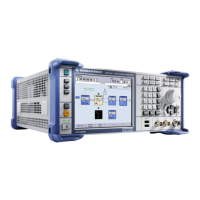Instrument Function
R&S
®
SMBV100A
452Operating Manual 1176.8016.02 ─ 17
Figure 5-29: Relation between the level settings
In the instrument, level values are represented as relative to full scale.
Fulfilling the prerequisites for a correct signal processing of the externally sup-
plied baseband signal
In the instrument, the crest factor, peak level and RMS level values can be adjusted
in one of the following ways:
●
Adjusted manually
If you have knowledge about these values, it is best to enter them directly (see
Crest Factor)
●
Estimated automatically by the internal measurement function
Use the function Auto Level Set to trigger the R&S SMBV to measure the input sig-
nal, estimate the the peak level and RMS level and calculate the crest factor out of
them.
Tip: To achieve correct signal leveling with external baseband signals, enable an
appropriate measurement time and perform a measurement.
For accurate level measurements, set the measurement period to a time value that
is long enough to capture several periods of the input signal.
●
Determined automatically (digital baseband input only)
The R&S SMBV can receive the values from the connected transmitter.
If the external digital signal source is a second Rohde & Schwarz instrument, it sig-
nals the peak level and RMS level of the signal over the digital input interface. To
enable the R&S SMBV to receive these values, trigger the DIG IQ Auto Setting
function.
In the two automatic way, the R&S SMBV adjusts the corresponding input fields with
the measured/received values. The internal gain control mechanism uses these
received values to adjust the input signal gain to achieve an optimal dynamic range.
Sample rate
●
External input signals with sample rates different than the system clock are resam-
pled, as illustrated on Figure 5-30.
Figure 5-30: Resampling principle of external digital baseband signals
External Baseband Signal - Baseband Input

